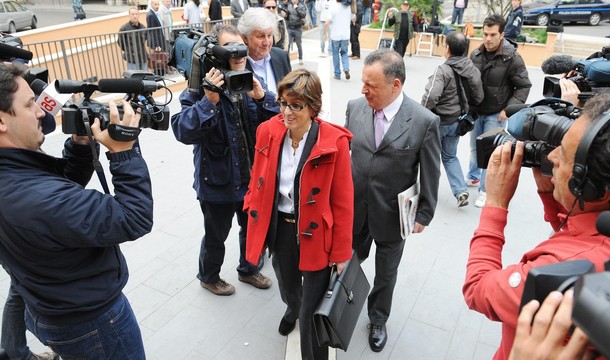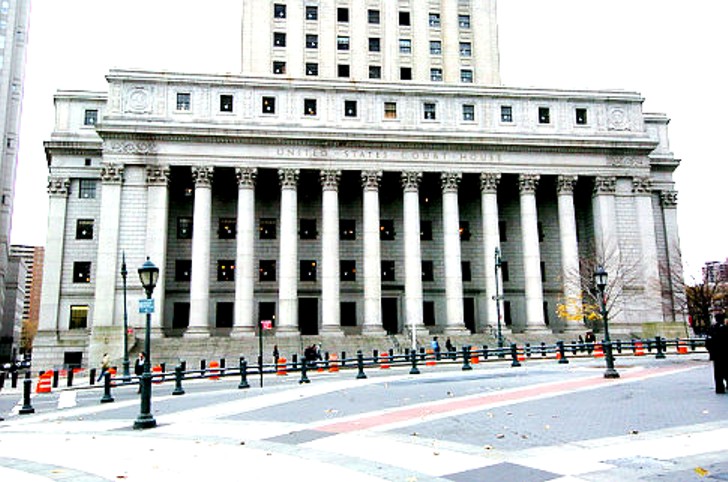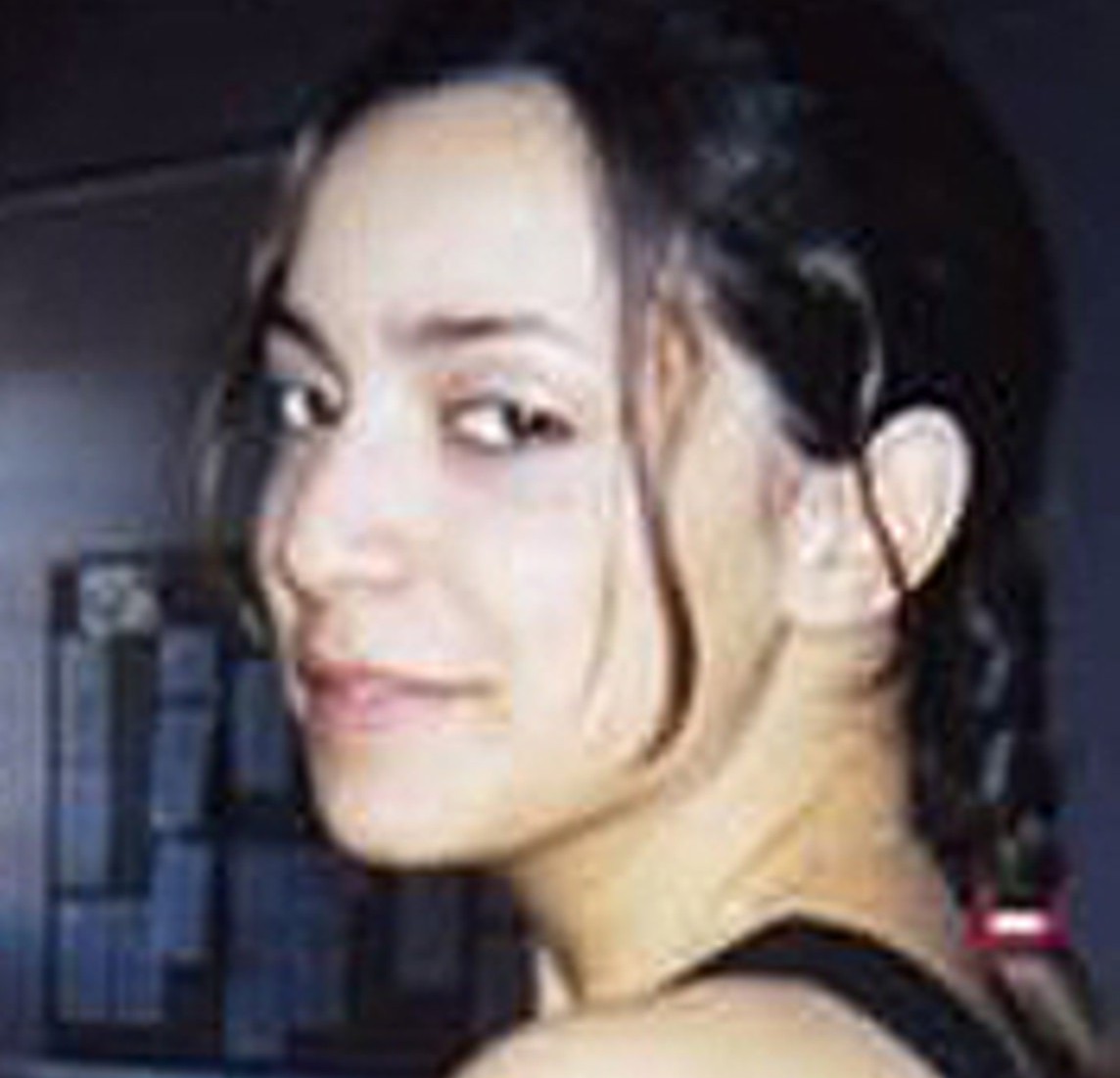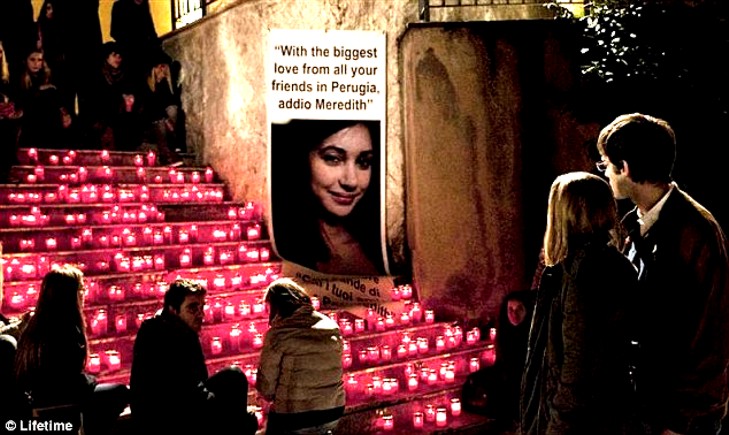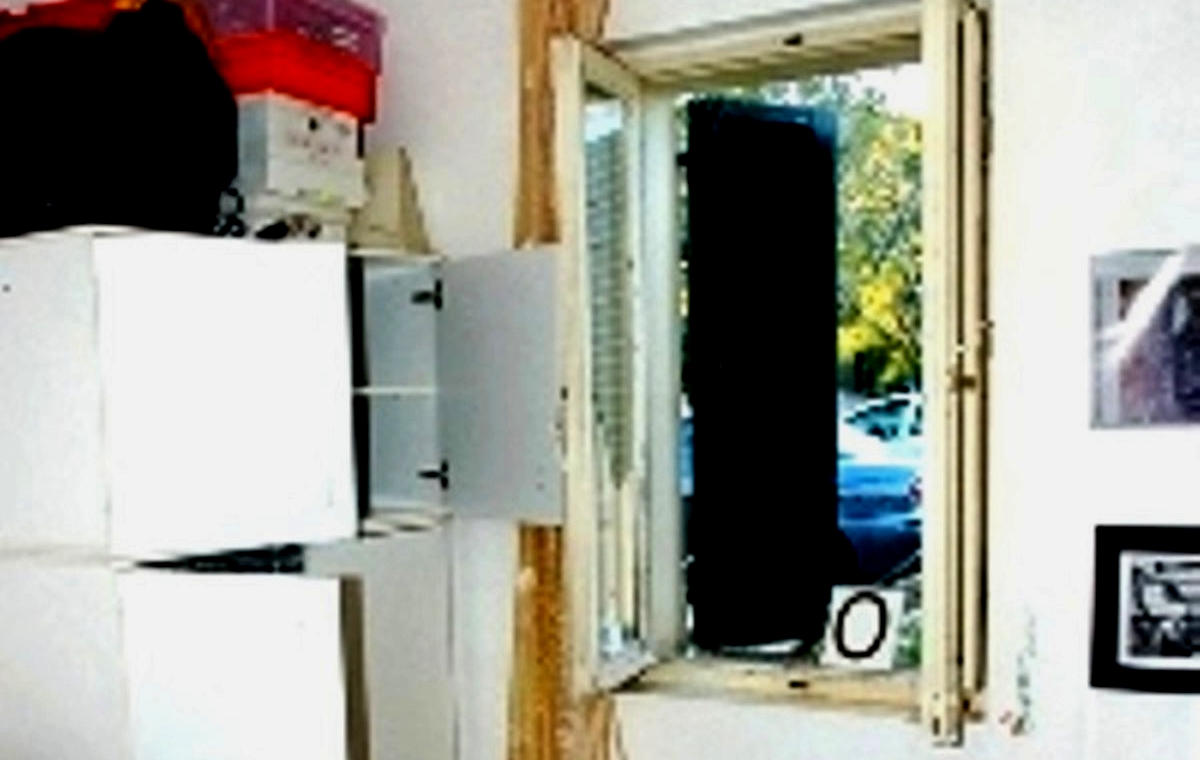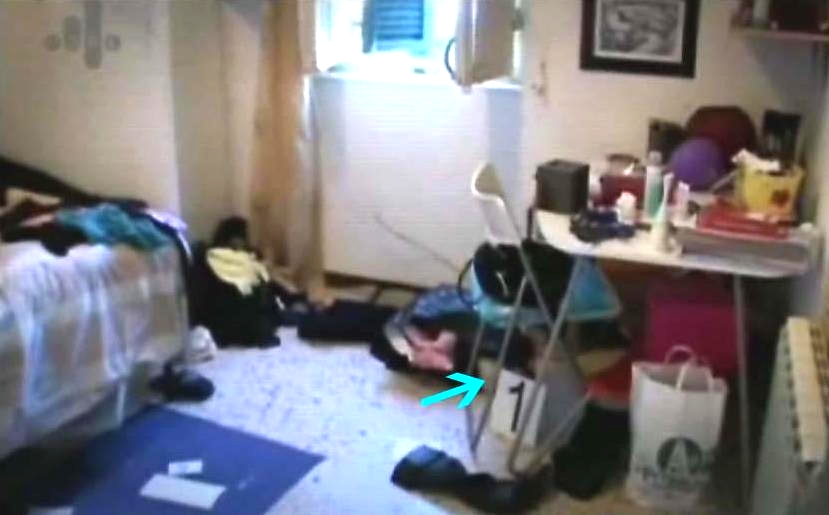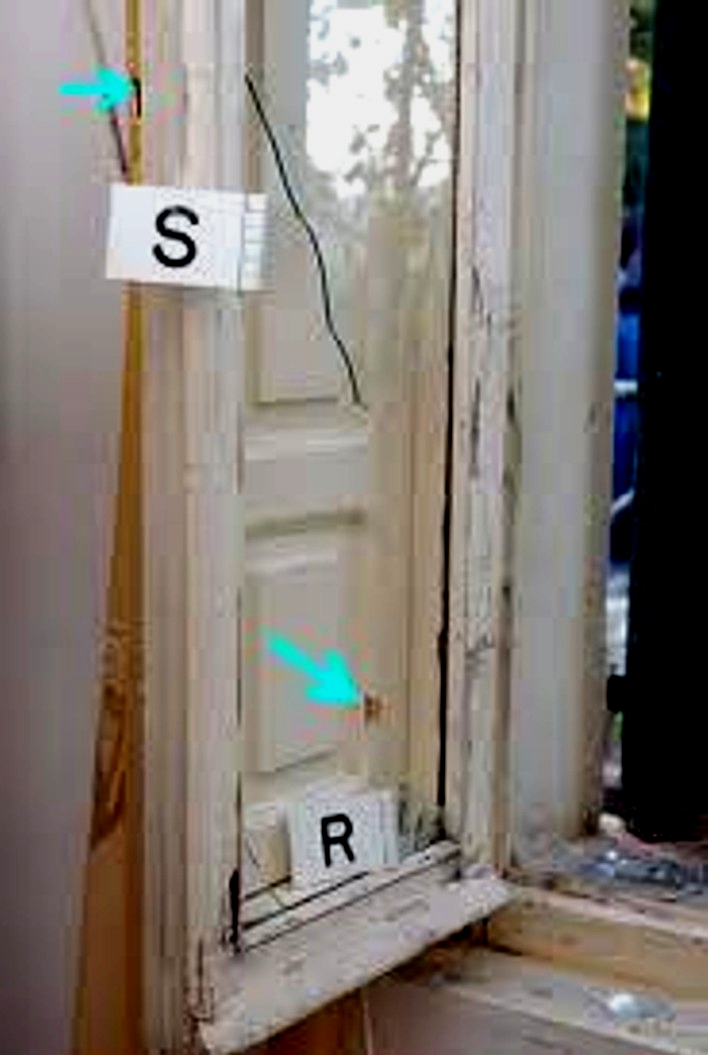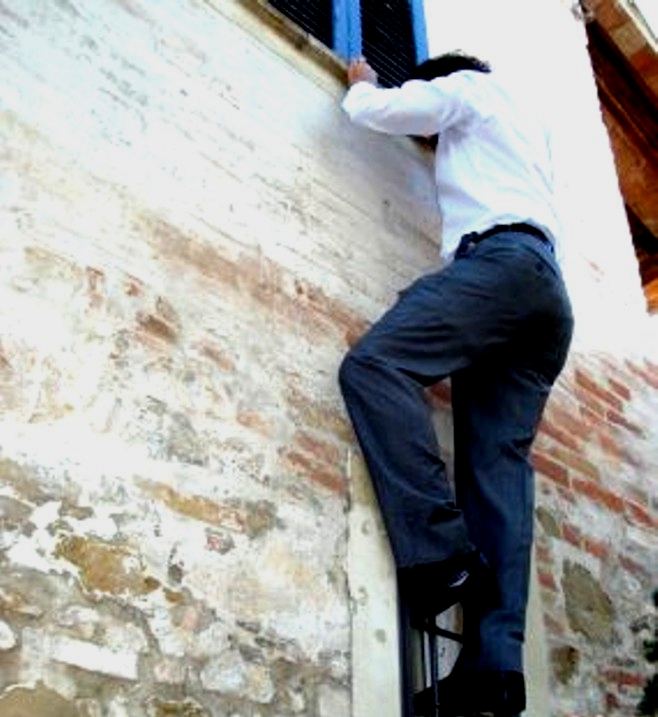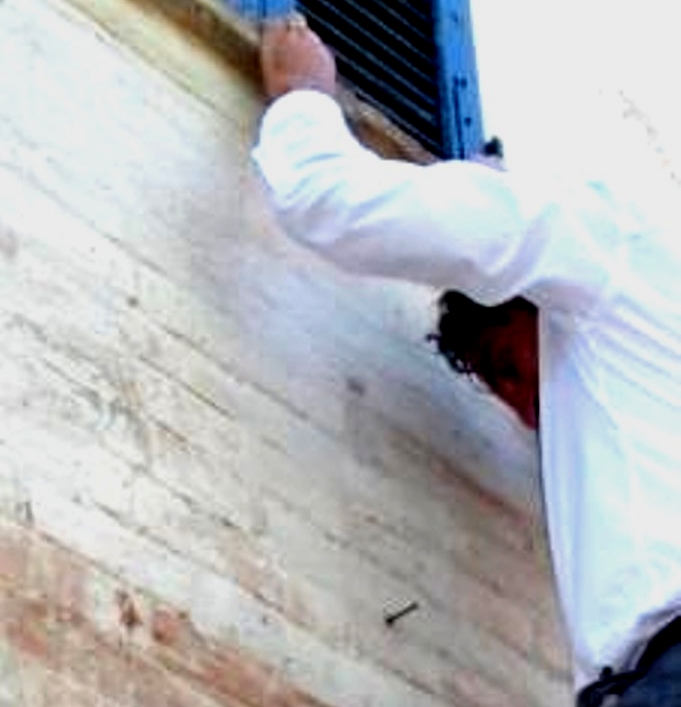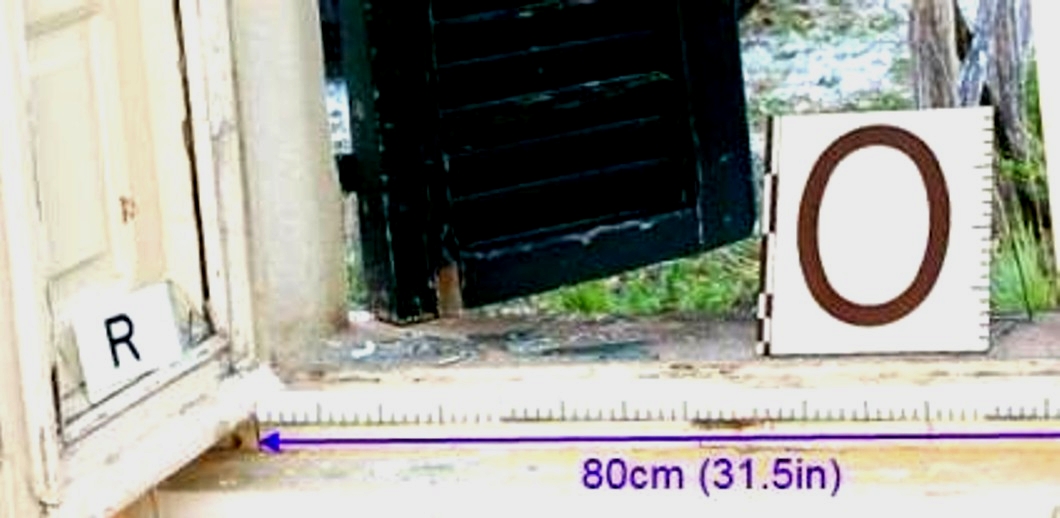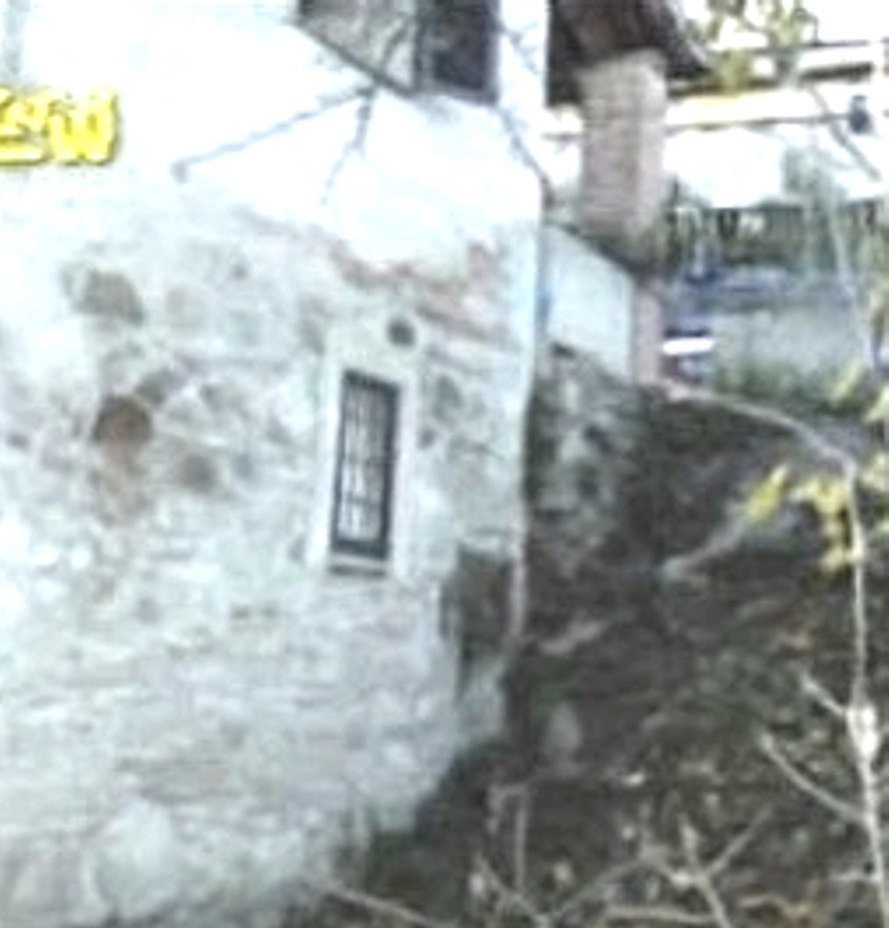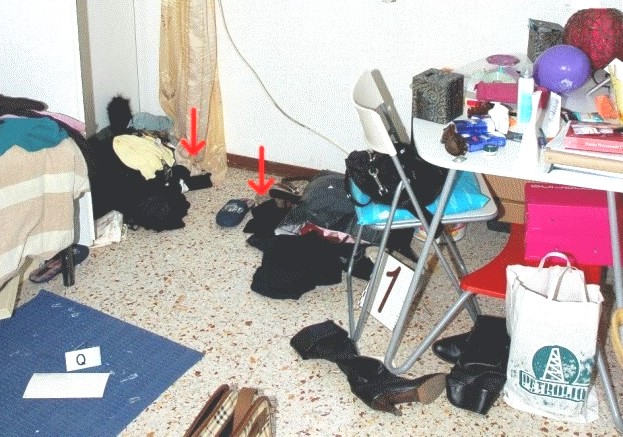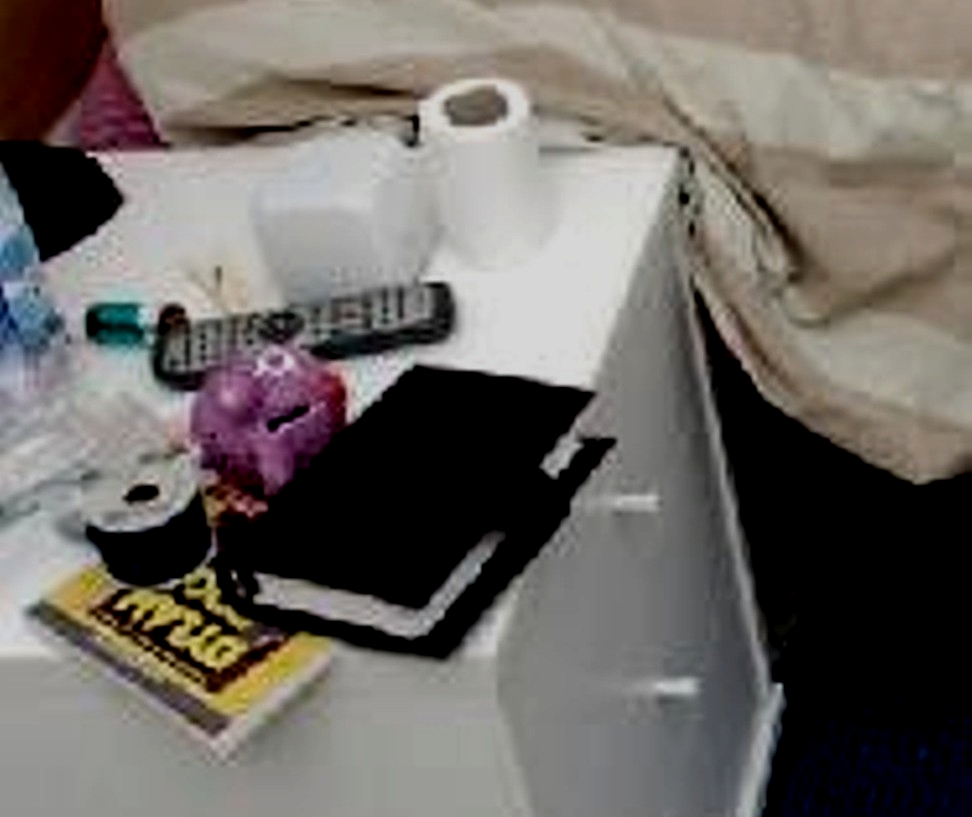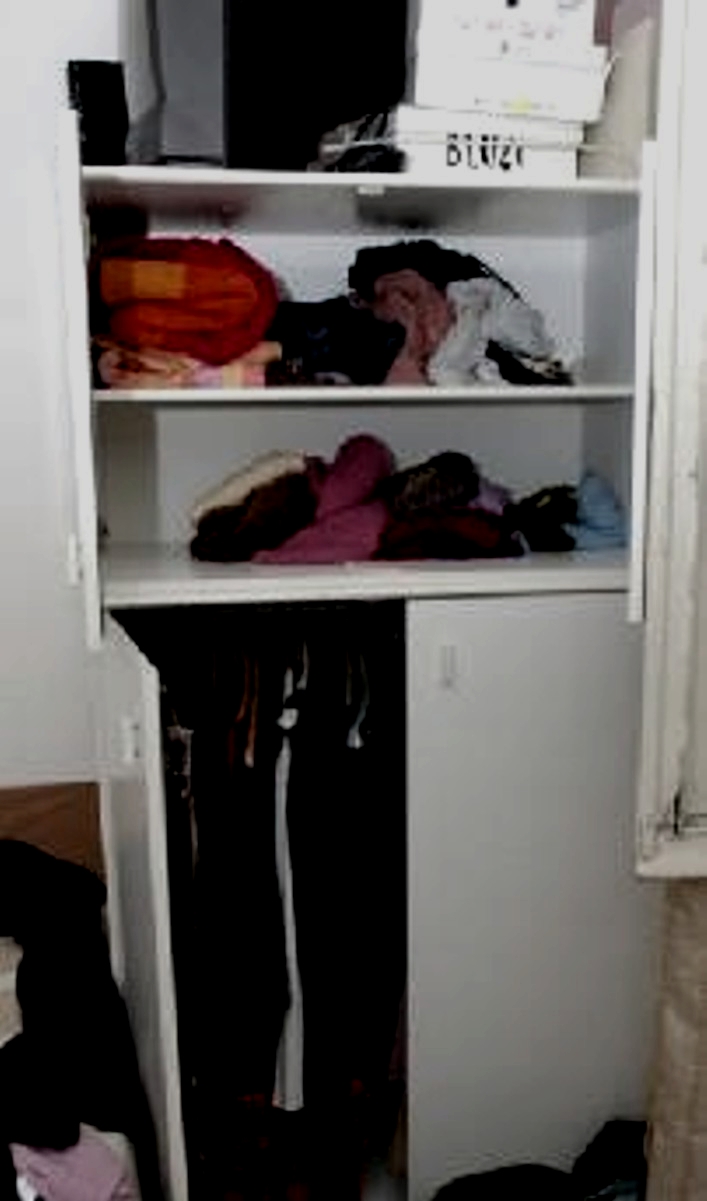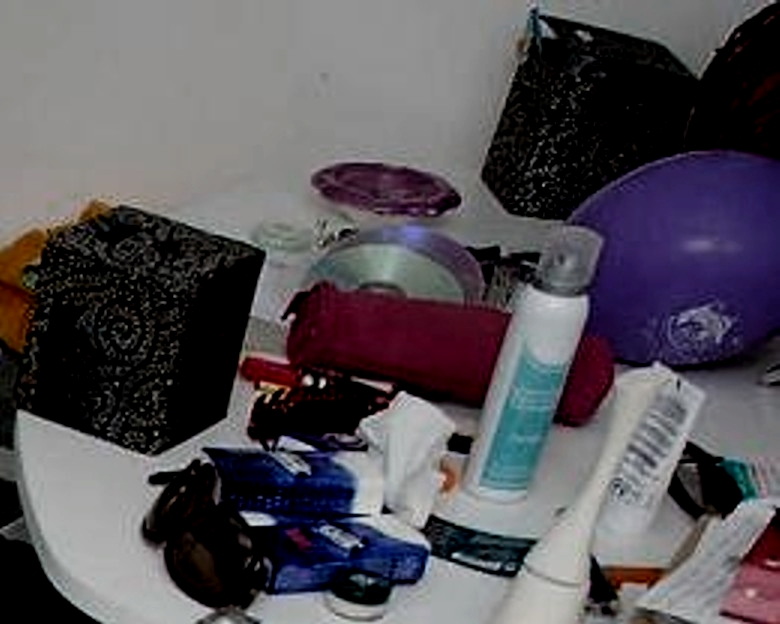
Headsup: To those many lawyers amazed that Knox did not get on the witness stand to head off a certain re-conviction: the best guess among Italian lawyers is that Knox's own lawyers feared ANOTHER calunnia charge if she repeated the crackpot and highly disprovable claims that she was tortured. The tough calunnia law is primarily a pushback measure against mafia meddling which is widely suspected in this case.
Thursday, February 17, 2011
The Daily Beast’s Barbie Nadeau Weighs The Pros And Cons Of The Lifetime Movie
Posted by Peter Quennell

[Above: Lifetime TV has an office suite in this giant hitech building which Google is presently purchasing]
We doubt if we are going to rate this film very highly. Already there are critical reviews.
And the Massei report shows overwhelming guilt, the grounds for appeal are slim indeed, and the Supreme Court of Cassation has ALREADY accepted that all three were part of the attack.
Barbie Nadeau’s report upon seeing a preview seems to confirm that the film will at least in part blow smoke and mislead the viewing audience by failing to convey those hard facts.
The movie does a commendable job slaloming between guilt and innocence as it stitches together known details of a very complicated case. It doesn’t shy away from controversial facts like how Knox accused Patrick Lumumba of the murder, or just how tough the Perugian police were on the 20-year-old American during her interrogations…. Lifetime lands squarely on the side of reasonable doubt when it comes to Knox’s conviction, but the network also does a fair job showing just why the jury in Perugia found her guilty.
Reasonable doubt? In fact that is a term that applies only to juries who were present in the courtroom the whole time, and in this case the guilty verdict was already unanimous. They had no reasonable doubt.
Sadly, John and Arline Kercher’s worst fears about the movie dwelling upon the graphic violence done to Meredith seem fully justified.
Indeed, the movie features globs of often-gratuitous violence around their daughter’s tragic death. Sure, it is a TV dramatization bent on ratings about a now-legendary murder, but the CSI-style black-and-white autopsy shots and a disturbing scene where Guede watches Meredith choking on her own blood are unsettling, even for those of us who have covered this case from day one. It’s one thing to see the crime scene video and hear testimony about how it might have happened, but it’s quite another to watch someone act it out in gruesome detail.
There seems to be little mention of the million-dollar public relations campaign that has so misled the public, and none at all of the inflammatory anti-prosecution anti-Italy bias of much of the UK and US media.
Not all is bad. Mr Mignini and his team are shown as “smart, capable investigators caught up in a terribly complicated crime….”. The Knox family are portrayed as “even-tempered and wholly genuine in support of their daughter”. Hayden Pantierre does “an admirable job playing the quirky Seattle native.”
But Amanda Knox herself apparently comes across as vague and someone who “could have simply been in the wrong place doing the wrong things at the wrong time.” We have already remarked in a previous post “We will be curious to see if Lifetime somehow depicts what a sad drug-driven slide into dependency and desperation the seemingly not-quite-right Amanda Knox appeared to be embarked on.”
However Meredith is said to be infectiously played, by Cambridge University graduate Amanda Fernando Stevens (image below), who we believe really did give the classy depiction of Meredith all she could.
Fortunately, Lifetime also focuses a fair amount of attention on Meredith, painting a portrait of a bright and beautiful young woman who was far more serious than her American roommate, but who had an infectious sense of humor and enviable charm. That careful attention to her charisma makes her murder all the more tragic.
Wednesday, February 16, 2011
More Excellent Examiner Reporting: This Time Profiling Curt Knox And Edda Mellas
Posted by Peter Quennell

[Above: Capanne Prison, where Amanda Knox was taped undercutting the claims her parents made]
The Examiner network has posted many reports on the case from at least half a dozen reporters.
They have been consistently well-researched, unbiased, and accurate. Today their website carries a comment on Amanda Knox’s parents’ indictment, and how they put themselves into this absurd mess.
So the question remains: will Amanda Knox be called to testify at the trial by her indicted parents - or by the police pursuing the suit? She herself has never publicly made the claims Curt and Edda did, with the minimalist exception of someone she can’t identify clipping her over the head.
That sole claim the interpreter present has made quite clear did NOT happen. And Amanda Knox was CAUGHT ON TAPE telling her mother Patrick Lumumba did not do it - that her charge was false, and accordingly she made NO mention of her accusation against him having been beaten out of her by the cops.
Leaving zero reason to accuse the cops of anything - let alone serially accuse them of criminal behavior again and again, globally. And also, Edda Mellas failed to report what Amanda actually told her. She too left Patrick to languish.
Tuesday, February 15, 2011
Curt Knox And Edda Mellas Defamation Trial To Go Ahead On July 4
Posted by Peter Quennell
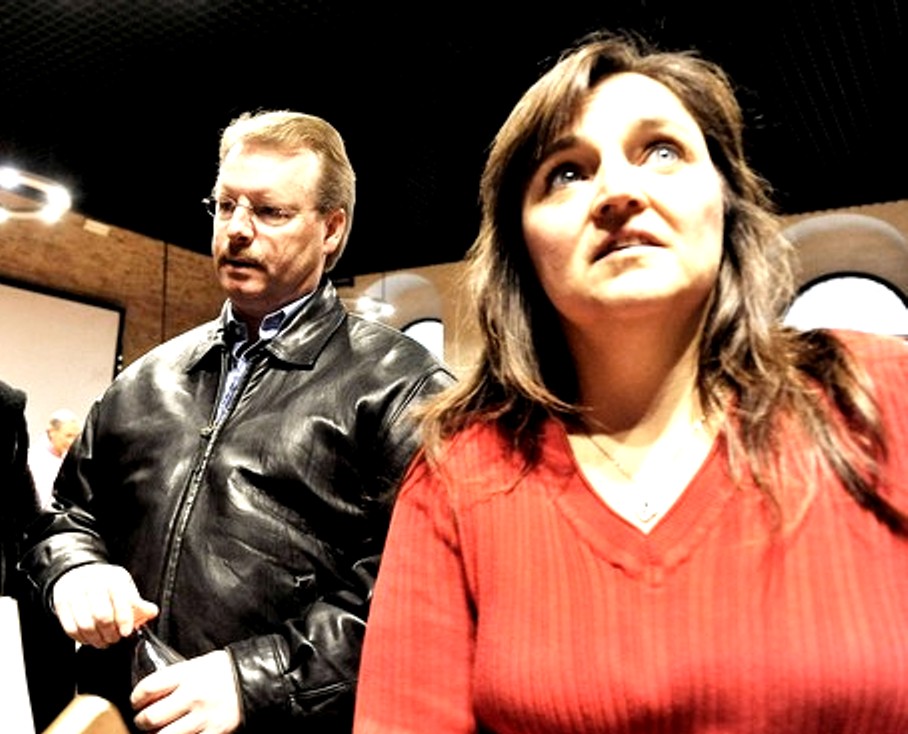
[Above: An image of Curt Knox and Edda Mellas in court shortly before the verdict late in November 2009]
Italy’s news service AGI is reporting that motions for acquittal have failed and that the defamation trial of Curt Knox and Edda Mellas will indeed proceed.
Curt Knox and Edda Mellas, the parents of Amanda Knox, were indicted today by the GUP of Perugia for the defamation of five policemen from the Perugia police who investigated the murder of Meredith Kercher….
The charge says the alleged defamation statements were posted in 2009 on the website of The Sunday Times. The story said they falsely attributed to the police some actions and conduct which is out of line with their official code of conduct.
In particular, the charge continues, it was related that, contrary to the truth, Amanda had not been assisted by an interpreter, she had not been given food or water, she was abused both physically and verbally, and she had been slapped on the back of her head with a threat “if you ask a lawyer that will make things worse for you.”
Knox’s parents are being defended by lawyers Luciano Ghirga and Maria Del Grosso, who asked today for the acquittal. The five police officers are represented by the lawyer Francesco Maresca.
The charges were filed by the police themselves and the prosecution is not involved. The illegal actions were alleged to have occurred after Amanda Knox arrived voluntarily and unrequested at the Central Police Station along with Raffaele Sollecito. She herself agreed to be further questioned as a witness, and so no lawyer was present.
After she fingered Patrick Lumumba, her questioning was stopped, and she was soon after questioned further as a suspect. Amanda Knox only made the slapping claim months later, while trying to explain why she fingered Lumumba, and she herself referred to the presence of an interpreter in her two-day stint on the stand in July 2009.
With the exception of a claim of a slap over the head by someone she has not ever identified, she confirmed she was not mistreated. Amanda Knox’s own trial for defamation resumes on 17 May. Her own lawyers have never ever claimed that any mistreatment took place, and they have never ever filed any complaint.
So. Can Curt Knox and Edda Mellas present evidence to refute the charges? And can they explain away all of these?
And at the trial, for which side will Amanda Knox testify?
We don’t know if Lifetime include the claimed hitting and other abuse in the movie - but it would seriously seem better not to.
Saturday, February 12, 2011
Sollecito Defense Team Breaking From Knox Defense Team On Legal Measures To Stop Lifetime Movie
Posted by Peter Quennell
The Amanda Knox team of Ghirga and Delle Vedova were ready to stop by legal means the showing of the Lifetime movie in Italy.
We presume they were only willing to go that far and no further because there are various signs that Edda Mellas and Curt Knox had a hand in the generation of this movie - not least that they have never denied it or decried it. Chris Mellas confirmed that they were helping out in his candid announcements that he tried to get Panettiere face to face in Capanne with Amanda Knox.
But there is already a huge separation between the Knox and the Sollecito defense teams - Giulia Bongiorno and Luca Maori (image above) have no liking at all for the runaway train of xenophobic conspiracy theorists.
And of course Raffaele Sollecito STILL does not confirm Amanda Knox’s attempted fifth alibi for the night that she was at his place all along.
We have already warned that the fact of this movie could make things very much worse for Amanda Knox.
Now it looks like this is happening. Giulia Bongiorno and Luca Maori want the movie delayed worldwide on the basis that it could SERIOUSLY damage their client’s prospects.
The large Italian news service ADNKronos is now reporting that if Lifetime do not confirm by this next Monday that the movie is to be held back until after the appeals are over, they will file suit in New York Federal court in Manhattan (image below).
If there is a Federal court session on this, we should be able to report from the front lines, hopefully with some shots, on the Lifetime producers trying to defend their bizarre movie.
Looking forward.
Friday, February 11, 2011
Perhaps Heeding Meredith Family Pleas And Our Open Letter Lifetime Claim Movie Now Less Shrill
Posted by Peter Quennell
If we are reading this somewhat cagey explanation by Lifetime executive producer Craig Piligian correctly, the scenes with Meredith have almost disappeared.
Lifetime is set to premiere the movie on February 21, but the channel has slightly altered their marketing in response to criticism from both Knox’s lawyers and the family of victim Meredith Kercher.
The channel recently removed the original teaser-trailer for the movie, which stars Hayden Panettiere as Knox, from its website and YouTube, and today replaced it with a new, slightly edited version.
The new promo no longer includes scenes depicting Kercher being assaulted, which caused a stir in the U.K., where she is from, and which her father called “absolutely horrific.”
If this is true then we have to thank you, Lifetime, for a kind gesture that matters a great deal to Meredith’s family and her many supporters worldwide.
Mr Piligian says the movie will air in the US starting 21 February and the UK and some other markets, but no longer in Italy.
Insiders also confirm that Amanda Knox will not air in Italy due to legal reasons, because Knox’s case is ongoing. Knox’s lawyers had sent a letter to Lifetime, asking the network to pull the clips down, arguing that the movie’s depictions might jeopardize her chance of a fair trial. A Lifetime spokesman confirmed that the network received the letter, but beyond that, they have not commented on the controversy.
We also presume that Lifetime had no wish to pin a calunnia target on their own backs, as the Italian police and investigators and prosecutors may have quietly warned them.
The producers and cast continue to make some rather loopy claims about how controversial the evidence actually is.
“This is a factual drama and we feel we did a very fair and balanced telling of the story, crafting a script from court records and other public documents,” executive producer Craig Piligian tells TV Guide Magazine.
“At the end of the movie people will be wondering whether she really did or didn’t do the things she’s accused of,” he says. “We weren’t leaning one way or another, but took a very even, fact-based approach, which ultimately allows the viewers to make their own decision.”
Amanda Knox is simply accused? Actually she already was unanimously convicted. The Supreme Court of Cassation has already accepted that all three were party to the attack.
Certainly the conviction is not final until Cassation confirms it (probably by late summer 2012) but that existing Cassation position really means it is all but game over. And Capanne Prison continues of course to be Amanda Knox’s home.
But the auspices behind the movie say they’ve made sure not to take sides in the debate over Knox’s guilt or innocence… Piligian said he screened the movie internally to his staff, and even in-house there’s no consensus on whether or not Knox was involved in the crimes. “Everyone’s divided, and the viewing public will likely be divided as well… That’s what makes this such a great story.”
No consensus? Try again. Read the voluminous evidence rather than simply watching a hedging semi-fictional film
We are finding that maybe 98 out of every 100 bright people who read the Massei report and the Micheli summaries do not have the slightest difficulty seeing that the case has been made and the first verdict a fair one.
We will watch the Lifetime movie for sure on 21 February.
We will be curious to see if Lifetime somehow depicts what a sad drug-driven slide into dependency and desperation the seemingly not-quite-right Amanda Knox appeared to be embarked on.
What a deservedly friendless, obsessive and bizarre person the heavy drug user Raffaele Sollecito seemed to be, despite all his deeply concerned father’s best efforts, in real life.
And what an exceptional fast-track student with an amazing future already mapped out the real victim, Meredith, really was. We believe Lifetime may have picked up some strong vibes of that.
Thursday, February 10, 2011
Report Of The Decay Of The Hard Pro-Knox Party Line In West Seattle
Posted by Peter Quennell

Former HQ of West Seattle Herald
West Seattle Groupthink Under Strong Fire
The Seattle Salmon reports with some amusement on how the residents are increasingly speaking out.
They whisper at the local library branch, nod to each other in line at the Morgan Junction Starbucks, and even occasionally email their true feelings to each other. What is this secret society? It’s not the Masons, Scientologists or even the wily Northwestern Republicans.
No, this fearful group is West Seattleites who think Amanda Knox did it. By “it,” they are referring to the 2007 murder in Italy of which she was convicted. Knox was raised in West Seattle and the community has rallied around her claim of innocence with a fervor that straddles the militant/cult divide.
But some in the community are not so sure and not so talkative about their doubt. One resident who demanded anonymity told the Seattle Salmon, “It’s like a police state out here. You have to go to the legal defense fundraisers ““ like six last year ““ or else you are ostracized at the Westcrest Off-leash area.”
Another said, “The groupthink is terrifying. You step outside of it and you’re like the stupid Regular Seattleite who jaywalks through the all-way crosswalk at The Junction ““ you’re all alone and danger could come at you from any direction. Plus they’d light your ass up on the West Seattle Blog. You’d have to move.”
Perhaps no surprises there. It has been a long time since pro-Steve-Shay comments on the West Seattle Herald have been in the majority. Yesterday he made this ludicrous claim.
Meredith’s father, John, who believes Knox is guilty and has a lawyer in the courtroom fighting to insure she and her boyfriend Raffaele Sollecito remain in jail.
These were the first two responses.
John Kercher’s lawyer is not ‘fighting’ anyone or anything. He has a legal duty to provide representation at the automatic appeal which Italy’s very liberal criminal justice system provides to all convicted criminals.
Your inflammatory, arrogant coverage of this legal process stinks. The US State Department doesn’t think there was anything wrong with the year-long legal process which convicted Knox and Sollecito of torture and murder, and neither do their victim’s family. Again, this doesn’t mean they are ‘fighting’, so grow up.
Mr. Shay atypically made only one glaring distortion in this article; The Kercher family lawyer is involved in the appeals process not to insure that Ms. Knox stay in jail, but rather to make sure the prosecution’s case is presented fairly and objectively, as was certainly done in the court’s verdict.
Not to make the lawyer sound one sided and intent on a path; there are way too many like Shay in the pro innocent Knox camp; this population has been known to lie and distort facts so as to exculpate their darling “West Seattle bred” Knox.
Nice work West Seattle.
Wednesday, February 09, 2011
On The Effects On Amanda Knox Of Her Movie Alter Ego Hayden Panettiere
Posted by Hopeful
An ABC News headline: “Amanda Knox Felt Ill When She Saw Herself Portrayed in New Movie”
Nikki Battiste.states that Knox was tearful in her weekly phone call home after having seen the trailer of the movie on prison TV news. Chris Mellas quoted her, “I was physically ill when I saw the images. I thought I was going to throw up.”
This reaction seems to spring from the strange feeling Knox had when seeing “a girl who looked like her, dressed like her, playing her life.” Mellas explains her frustration at having no control over her life or how her life is portrayed.
Perhaps this seeing herself through objective eyes is shaking up her fragile sense of identity. She explored that theme in her appeal speech, all too fully for the occasion. She’s not “that girl” painted by the prosecution.
Maybe in this movie she is reminded of all the glories that were lost seeing the colors and happy scenes of bouncing carefree Hayden/herself flitting around Perugia at the university that she so loved; and the love scene with Raffaele, the picturesque architecture of Perugia with the film’s golden lighting, even her long hair as Hayden wears wig, treasured times of joy.
This film renews those days of wine and roses, however brief, and it must be horrifying to have traded all that freedom for the current reality.
Nikki Battiste reports, “Her family said she is not aware of the magnitude of the press surrounding her life, and that she avoids watching television and reading newspapers.”
That sounds inaccurate or blatantly false, because she faces a jungle of reporters and cameras each time she enters the courtroom and her family has been in constant contact with her for three years giving ample time to discuss how she is perceived, the press they are surrounded with.
She has probably been informed of every bit of the internet interest in her case, both pro and con. We know this because she refers to the media coverage of her reputation in her appeal speech. Her access to newspapers in prison is no doubt limited, but overall she must surely be apprised of the hubbub about her trial. So her being “not aware” is a total exaggeration, so too perhaps is her reported reaction.
If she sees the movie as veering from the truth of what happened the night of the murder, her reaction may be mixed: grateful that the real details are not known but fearful that even the false rendition makes a case for guilt, and wondering what effect this may have on her appeal, if any.
Case of sowing and reaping here?
She may be bearing the brunt of lies in this movie after having told so many herself. She may be a great deal more envious of Hayden Panettiere than she ever was of Meredith, and resent this lovely actress’s freedom to vicariously take over her life and her sufferings while getting famous and paid for it.
It’s like two actresses vying for a juicy role and one losing out to the other, the loser being Foxy, ironically she being the authentic character and born to play the role. She may hate to lose her claim to fame and the spotlight to Hayden.
She may envy Hayden’s looks and charisma, and feel she has been overshadowed once again, beaten at her own game. It’s hard to imagine how conflicted this movie must make Amanda feel. If she knows her family has received financial benefits from it with some trickle down benefits to herself, that may be some consolation.
Identity confusion from seeing oneself portrayed by another is a powerful mirror held up to the self even if one is innocent. If one is not very self-aware to begin with, seeing oneself caricatured or portrayed by another like a game of charades could make a person feel unbalanced and discombobulated.
Amanda is fortunate to have plenty of quiet time without media frenzy or court dates so she can process this dramatic development.
It’s equally possible that her tears and nausea are an act equal to Hayden’s, initiated by her shrewd instinct. They could be a falsehood concocted by her family to camouflage the fact that she’s secretly revelling in every minute of increased notoriety. She may be silently thanking Hayden for promoting her status on TV.
For that matter it might not be mutually exclusive, this love of the limelight once again, but anger that she has been cut out as scriptwriter. The issue she has with “no control over her life…how her life is portrayed” does sound rather like the bitter tears of a wounded egomaniac.
Friday, February 04, 2011
Open Letter To Everyone Remotely Involved In Lifetime’s Crass Enterprise “Murder on Trial in Italy”
Posted by Peggy Ganong
Video version and all co-signatories of the letter below
The parents of Meredith Kercher are not the only ones who are appalled and saddened by the making of the soon-to-be aired Lifetime movie “version” of their daughter’s brutal murder, which occurred in 2007 while she was an Erasmus scholar in Italy. Though we cannot begin to truly imagine the depth of their ongoing pain, we can certainly empathize with them. And we can share their outrage at the very idea of showing graphic footage that purports to depict “what happened” to their beloved daughter. That John Kercher, Meredith’s father, was led to believe otherwise just makes matters worse.
At the risk of creating yet more publicity ““ which could ultimately play into the hands of the producers and others associated with this telefilm, commissioned by and scheduled to air on the US cable channel Lifetime ““ we wish to condemn, in the strongest possible terms, everyone who has played a role in bringing this crass enterprise to fruition. The film is not just premature and untimely ““ though it is indeed both, since two of the three unanimously convicted in December 2009 for their role in Meredith’s death are currently awaiting the first of two appeals, which are automatic in Italy ““ it is also just plain wrong. And it will continue to be so in ten, twenty or thirty years’ time.
What possible justification could there ever be for inflicting this kind of pain on the real-life, grieving family of Meredith Kercher? Does it enhance our understanding of this heinous crime in any way? No, it does not. Does it serve to dissuade others from engaging in such acts? No, it does not. On the contrary, it breeds the kind of callous disregard for human life and lack of empathy that led to this gratuitous act of violence in the first place and that apparently characterizes those who have produced, directed and otherwise participated in the project.
In some respects, the damage is done as far as Meredith’s family are concerned. The footage is out there thanks to the efficiency of the World Wide Web. Now, there are two ways to bring partial reparation and maybe a little consolation to the Kercher family: one is to immediately remove all of the offensive footage from the internet, as John Kercher has politely requested. The other is to simply refrain from watching the film when it is broadcast on the Lifetime channel. Use the time to let the people at Lifetime know that you are unhappy with their lack of basic decency and fellow feeling, and that you plan to impose a personal ban in your house on the channel. There is a third way, but only the people at Lifetime can bring it about: that is to quietly but quickly pull the film from its line-up.
Just over three years ago, Meredith Kercher was a living, breathing, joyous young woman. She was also, and still is, someone’s daughter, someone’s sister, someone’s friend and someone’s neighbour. From what we have heard, she brought joy to all who knew her. None of these people deserve the gratuitous pain and suffering that this film and this footage will surely produce. Adding insult to injury, the film apparently focuses in particular on one of the three convicted killers, contributing indirectly to the well-financed and well-orchestrated PR effort intended to garner sympathy for and turn her into a “minor celebrity.” We wonder why, if Amanda Knox’s family and friends are opposed to this celebrity status and tabloidization, they did not do more from the outset to nip this project in the bud. The world knows by now that they have easy and apparently unlimited access to the media. Why have they not used just a few minutes of this access to let it be known that they think Lifetime should scrap the project? Why have they not threatened a lawsuit, claiming that until all appeals are exhausted this kind of film could turn the jury against Amanda Knox?
Like Arline Kercher, Meredith’s mum, we wonder why only the name “Amanda Knox” appears in the title of the film when the victim is named Meredith Kercher. And finally, we wonder why, if Amanda Knox’s family and friends are unassociated with this project, as they claim to be, they are being given an hour of airtime directly following its scheduled showing?
By Peggy Ganong, Seattle
Cosignatories with more to come
Neville Sprigg, England
Dr. Kathy Graham, B.C. Canada
Jane Blakelock Ohio
Claire Bennett, Bristol, UK.
Ann-Marie Thornton, Turkey
Rich Towle, California, USA
Neil Kazwell, St. Louis, MO
Cathy Armer, Boston MA
Nick Kitto, Barcelona, Spain
Mara Loughridge, Florida, USA
Dr. Craig Gerard, Boston, Massachusetts
David Llewellyn Smith, Scotland
Lola Kassim, Cheshire, England
John Crawford, Kent, England
Kevin Mackintosh, Va, USA
Barbara Taylor, Ohio, USA
Sylviane Pompei, France
Andrew James, Germany
Doug Clement, Portland
Samantha Andrews, Derbyshire UK
Patrick Critien, Sliema, Malta
Janet Chapman,Sheffield UK
Theo Stobbe, The Netherlands
Renate Lauditsch, Austria
Laura Watkins, Berkeley, California
Rachel Ross, California, USA
Dr Rosemarie Levine New York, NY
Miriam Bell Khounsary, Seattle
Robert Harrison Kingston-Upon-Hull UK
Amy Revell, United States
Julia Perez, southern Spain
Beth Zaring, Wellston, Ohio
Martha Shamp, Auburn Alabam
Stanley Champ.Garryhinch, Ireland
Heather Good, Whatcom County, WA, US
Katherine Phillips, Barry, Wales
Kris Arnason, Seattle US
Maria Fifield, Buxton, Derbyshire
Simon Gardner Oxford UK
Peter Quennell New York
Lifetime TV Appear To Have Lied And Invented False Facts For Their Horrific Knox TV Movie
Posted by Peter Quennell
These are all of our previous posts on this hapless film, which defense lawyers had said they might sue to be put on ice until after the appeals are all done.
There seems to be growing outrage in the media (read the many angry comments down below there) over what seems the sensational promotion and the offensive and misleading content of the film.
The film was made in Milan and Rome and it is due to air in the US on Monday 21 February, and thereafter in various other countries around the world. .This is the film that both Arline Kercher and John Kercher had spoken out very strongly against. It appears from the trailer and the still images to contain various manufactured scenes seemingly designed to enhance Knox.
1) This scene at the top certainly did NOT take place, as Sollecito and Knox bizarrely chose to go for a pizza rather than join the grieving crowd at the memorial service for Meredith.
Among all who knew Meredith who were still in Perugia, they were the ONLY ones to refuse to attend. Neither Knox nor Sollecito have ever shown genuine sympathy for Meredith or for her family and friends.
2) This scene idepicts Meredith in an amorous position on top of Rudy Guede. This did NOT take place. Neither the Micheli court NOR Guede’s two appeal courts NOR the Massei court accepted that. Four courts rejected it as a lie and a defamation of the victim.
If Meredith were still alive, this would certainly be defamatory. Meredith had a headache that night and was tired after staying out most of the night before (Halloween), and she intended to finish a homework assignment and go to bed. She already had a boyfriend that she liked, and unlike Knox had zero history of sleeping around.
3) Lifetime told Meredith’s father John and many others in a public statement (they have never ever been in touch with the family quietly and directly) that the film would NOT depict the crime against Meredith, regardless of what angle Lifetime took toward Knox. The timeline would stop short of that.
And yet this scene show Meredith being savagely attacked by three people - exactly what Meredith’s family had feared most.
Right after the movie, Lifetime will apparently give the Knox-Mellases a full hour to sell their usual self-serving fabrications and half-truths.
And meanwhile, still not one word from Lifetime for the family of the real victim. Lifetime is a smallish network with a mostly elderly female demographic, and it mostly focuses with varying sympathy on women who have been hurt or killed. The REAL victims.
So what happened here?
Tuesday, February 01, 2011
Explaining The Massei Report: A Visual Guide To The Faked Break-In Via Filomena’s Window
Posted by pat az
1. Post Overview
Cross-posted from my own website on Meredith’s case at the kind invitation of TJMK.
The Massei Report on the trial and sentencing of Amanda Knox and Raffaele Sollecito looks into whether or not a break-in is supported by the evidence available in the room with the broken window.
It concludes that the broken window and room in disarray - Filomena’s bedroom - are an “artificial representation”, ie. that the break-in was faked. After seven pages of review of the evidence, the Massei Report states:
“the situation of disorder in Romanelli’s room and the breaking of the window pane constitute an artificial representation created in order to orient the investigations towards a person who, not having the key to the front door, was supposed to have entered through the previously broken window and then effected the violent acts on Meredith which caused her death.
What follows is a look at the comments in the Massei report compared with crime scene and other photos. All quotes are from the English translation prepared by unpaid volunteers at PerugiaMurderFile.org. The section on the scenes in the bedroom begins on page 47 and continues to page 55. Some sentences in the paragraphs below have been omitted for brevity, and can be read in full in the original.
2. Knox Finds The Scene
Then (Amanda) went into another room and noticed that the window had been broken and that there was glass inside. She told these things to her and the other girls present. Then she related that she had gone back to Raffaele’s house and had rung Filomena.
I)n one of the telephone calls to Romanelli, Amanda spoke of that smashed window and of the possibility that someone could have entered the house through the broken place; she said this also in the telephone call to 112 and in the first declarations to the Postal Police.
Also in the e-mail of November 4, 2007, sent by Amanda to 25 people in the US, she hypothesises that a burglar could have entered the house and says she looked around to see if anything was missing.
Filomena Romanelli, disturbed by this phone call, had rung Amanda back without receiving a reply and when, a little later, she had succeeded in speaking to Amanda, Amanda had told her that in her room (i.e., in Ms. Romanelli’s room) the windowpane was broken, everything was in a mess, and that she should come back home.
Filomena Romanelli had ascertained from a quick check of her room, even though (it was) in a complete mess with the windowpane broken, that nothing was missing.
It must be held that when Filomena Romanelli left the house in via della Pergola, she had pulled the [interior] shutters towards the interior of her room, although she did not think that she had actually closed them; furthermore, because they were old and the wood had swelled a bit, they rubbed on the windowsill; to pull them towards the room it was necessary to use some force (“they rubbed on the windowsill”); but in this way, once they had been pulled in, as Romanelli remembered doing, they remained well closed by the pressure of the swelled wood against the windowsill.
It cannot be assumed - as the Defence Consultant did - that the [interior] shutters were left completely open, since this contradicts the declarations of Romanelli, which appear to be detailed and entirely likely, considering that she was actually leaving for the holiday and had some things of value in her room; already she did not feel quite safe because window-frames were in wood without any grille.
Also, the circumstance of the [interior] shutters being wide open does not correspond to their position when they were found and described by witnesses on November 2, and photographed (cf. photo 11 already mentioned).
Now, for a rock to have been able to break the glass of the window without shattering the outside shutters, it would have been necessary to remove the obstacle of the shutters by opening them up.
Consequently, since the shutters had been pulled together and their rubbing put pressure on the windowsill on which they rested, it would have first been necessary to effect an operation with the specific goal of completely opening these shutters.
The failure to find any instrument suitable for making such an opening (one cannot even see what type of instrument could be used to this end) leads one to assume that the wall would have to have been scaled a first time in order to effect the complete opening of the shutters, in order to enable the burglar to aim at the window and smash it by throwing a large stone - the one found in Romanelli’s room.
He would then have to have returned underneath Romanelli’s window for the second climb, and through the broken glass, open the window (balanced on his knees or feet on the outside part of the windowsill), otherwise he would not have been able to pass his arm through the hole in the glass made by the stone) and reach up to the latch that fastened the window casements, necessarily latched since otherwise, if the casements had not been latched, it would not have been necessary to throw a rock at all, but just to open the shutters and climb inside.
The “climber” would also need to rely on the fact that the [interior] shutters were not actually latched, and also that the “scuri” ]blackout blind] had not been fastened to the window-frame to which the broken pane was attached; otherwise it would not have been possible to open them from the outside; nor would it have been possible, even breaking the glass, to make a hole giving access to the house, since if these inner panels had been closed, they would have continued to provide an adequate obstacle to the possibility of opening the window, in spite of the broken pane.
This scenario appears totally unlikely, given the effort involved (going twice underneath the window, going up to throw the stone, scaling the wall twice) and taking into account the uncertainty of success (having to count on the two favourable circumstances indicated above), with a repetition of movements and behaviours, all of which could easily be seen by anyone who happened to be passing by on the street or actually coming into the house.
But beyond these considerations, there are other elements which tend to exclude the possibility that a burglar could have entered the house through the window of Romanelli’s room.The double climb necessary to attain the height of three and a half metres would have left some kind of trace or imprint on the wall, especially on the points on the wall that the “climber” would have used to support his feet, all the more as both the witnesses Romanelli and Marco Zaroli gave statements indicating that the earth, on that early November evening, must have been very wet (..6) (p50)
In fact, there are no visible signs on the wall, and furthermore, it can be observed that the nail ““ this was noted by this Court of Assizes during the inspection ““ remained where it was: it seems very unlikely that the climber, given the position of that nail and its characteristics, visible in the photo 11, did not somehow “encounter” that nail and force it, inadvertently or by using it as a foothold, causing it to fall or at least bend it. (p50)
The next fact to consider is that the pieces of glass from the broken pane were distributed in a homogeneous manner on the inside and outside parts of the windowsill, without any displacement being noted or any piece of glass being found on the ground underneath the window.
This circumstance, as confirmed also by the consultant Pasquali, tends to exclude the possibility that the rock was thrown from outside the house to create access to the house through the window after the breaking of the pane. The climber, in leaning his hands and then his feet or knees on the windowsill, would have caused at least some piece of glass to fall, or at least would have been obliged to shift some pieces of glass in order to avoid being wounded by them.
Instead, no piece of glass was found under the window, and no sign of any wound was seen on the pieces of glass found in Romanelli’s room. It can moreover be observed that the presence of many pieces of glass on the outside part of the windowsill increases the probability of finding some small pieces of glass on the ground underneath, since there seems to be no reason that so many pieces of glass would all stop just at the edge of the windowsill without any of them flying beyond the edge and falling down to the garden below. (p51 & 52)
On this subject it is also useful to recall that at the hearing of April 23, 2009, the witness Gioia Brocci mentioned above declared that she had observed the exterior of the house, paying particular attention to the wall underneath the window with the broken pane, the window of the room then occupied by Filomena Romanelli.
She said: “We observed both the wall”¦underneath the window and all of the vegetation underneath the window, and we noted that there were no traces on the wall, no traces of earth, of grass, nothing, no streaks, nothing at all, and none [39] of the vegetation underneath the window appeared to have been trampled; nothing” (p. 142 declarations of Gioia Brocci). (51)
This situation, like all the other glaring inconsistencies, is adequately and satisfactorily explained if one supposes that the rock was thrown from the inside of the room, with the two shutters pulled inwards so that they blocked the pieces of glass from falling to the ground below. Once the glass had been broken from inside, the rock was set down at some place in the room, and the shutters were pushed towards the outside, being thus opened from within the room. (p51)
But the fact that all this was in fact just a simulation, a staging, can be deduced from further circumstances. From the photos taken by the personnel of the Questura (photos 47 to 54 and 65 to 66) one can perceive an activity which appears to have been performed with the goal of creating a situation of obvious disorder in Romanelli’s room, but does not appear to be the result of actual ransacking, true searching for the kind of valuable objects that might tempt a burglar.
The drawers of the little dresser next to the bed were not even opened (photo 51 and declarations of Battistelli who noted that Romanelli was the one who opened the drawers, having found them closed and with no sign of having been rifled: see p. 66 of Battistelli’s declarations, hearing of Feb. 6, 2009).
The objects on the shelves in photo 52 appear not to have been touched at all; piles of clothes seem to have been thrown down from the closet (photo 54) but it does not seem that there was any serious search in the closet, in which some clothes and some boxes remained in place without showing any signs of an actual search for valuable items that might have been there (photo 54).
It does not appear that the boxes on the table were opened (photo 65) in a search for valuable items. And indeed, no valuable item (cf. declarations of Romanelli) was taken, or even set aside to be taken, by the ““ at this point we can say phantom ““ burglar.
What has been explained up to now thus leads to the assertion that the situation of disorder in Romanelli’s room and the breaking of the window pane constitute an artificial representation created in order to orient the investigations towards a person who, not having the key to the front door, was supposed to have entered through the previously broken window and then effected the violent acts on Meredith which caused her death.
Footnotes
(...1) The Massei Report in English is readable and downloadable via the link at the top of this page.
(..2) The consultant for the defence actually assumed that this had been done; in his exhibit, he assumed that the shutters were not present in front of the window
(..3): “if the shutters were closed, he could not have passed through, that is obvious”, cf. declarations of the consultant for the defence, Sergeant Francesco Pasquali, p. 22 hearing July 3, 2009.
(..4): (the window in Romanelli’s room is located at a height of more than three and a half metres from the ground underneath, cf. photo 11 from the relevant dossier)
(..5):,which are the wooden panels [scuri=non-louvered shutters in interior of room] that usually constitute the outer side (or the inner, depending on the point of view) of the window [attached to the outer edge of the inner side of the window-frame]


